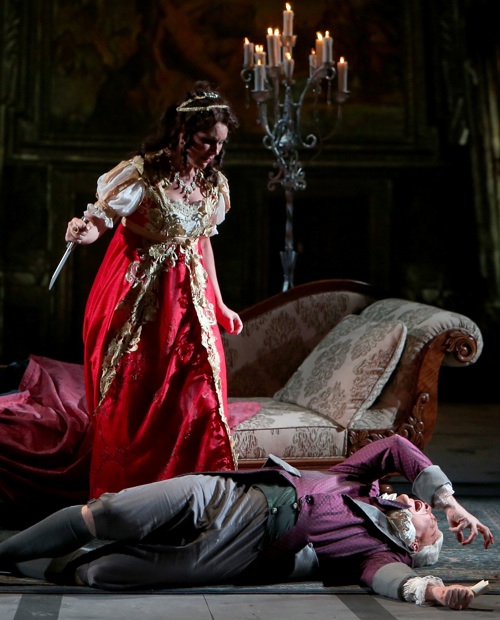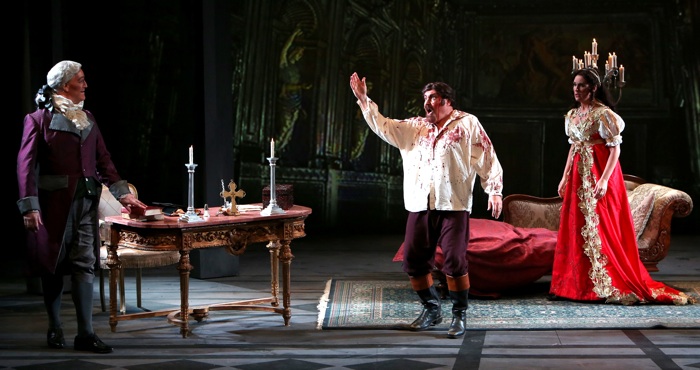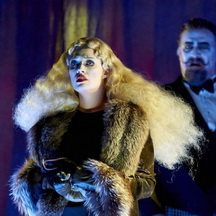Grand Opera the way it is meant to be—shoe-horned into a community theater
When all the elements come together, opera has an emotional impact that is unmatched among the arts. Those elements surely came together last Friday, Oct 11, for the opening of West Bay Opera’s Tosca. A talented cast, excellent musicians, and inspired conducting brought Giacomo Puccini’s dark celebration of passions to a boil in the intimate Lucie Stern Theatre.
Usually, opera’s greatest voices have to holler to fill drafty halls, sacrificing musicality for muscle. So it was truly a gift to hear opera performed in this smaller venue, and to hear decent singers able to embrace nuance.
Artistic director José Luis Moscovich conducted tautly, building the drama in waves to its culmination. Puccini wove his score with a breadth of colors, and scaled his spaces from the intimate to the universal, augmented by vocal feats that ran the gamut from mysterious to majestic. And all this is built on a libretto of solid drama from a play by Victorien Sardou, which teases us back and forth between hope and horror.
The opera’s rich score is full of sudden tensions, musical quotes, and leitmotifs to suggest characters and mood, and an unusual intertwining of very different vocal and instrumental lines. An example of that last is E lucevan le stele, where a clarinet solo takes the melody for the first two stanzas as the tenor, Cavaradossi, replies almost in a monotone, before soaring in for a reprise of the clarinet. Tenor David Gustafson did a gorgeous job of that aria (to thunderous applause) and a solid job throughout.
 His lover, Tosca, was sung by Stacey Stofferahn with a dry beauty, very rich in the midrange. Her big moment came in “Vissi d’arte” (I lived for art), one of the most poignant arias in the literature, which arrives, unexpectedly, in the midst of the Cardinal’s loathsome demands and the groans of a tortured tenor(!). Here, Puccini also plays on two approaches to aria: a slow vocal descent that mirrors Tosca’s noble despair, followed by a vaulting Art Song that first is sung by the strings before passing it to voice.
His lover, Tosca, was sung by Stacey Stofferahn with a dry beauty, very rich in the midrange. Her big moment came in “Vissi d’arte” (I lived for art), one of the most poignant arias in the literature, which arrives, unexpectedly, in the midst of the Cardinal’s loathsome demands and the groans of a tortured tenor(!). Here, Puccini also plays on two approaches to aria: a slow vocal descent that mirrors Tosca’s noble despair, followed by a vaulting Art Song that first is sung by the strings before passing it to voice.
Bass Philip Skinner inhabited the role of the evil Cardinal Scarpia, to such effect that there were many “boos” among the “bravos.” His is a voice of gravel and silk, matched by acting of exceptionally high caliber. I heard Skinner just two weeks ago as the Doctor in Vanessa with the West Edge Opera, and was surprised that his soothing and bumbling persona could transform into such palpable malice—and all with a stunning voice.
Bass William O’Neill as Angellotti and Carl King as the comic priest rounded out this excellent cast, directed by Richard Harrell. The imaginative sets, by Jean-Francois Revon, distorted the perspective to draw us into the action, particularly in the first act, with a video backdrop that worked to replace the grandeur of the bigger opera houses.
When you add top Bay Area musicians playing in a finely balanced reduction, some beefy chorus moments and the lovely Silicon Valley Boychoir, you really can’t go wrong. Well, actually, I’m sure you can, and there may have been opening night mistakes, but they made the magic happen and the audience staggered out with hearts beating fast.
If you are looking for a little love—or murder, execution or suicide—this production won’t let you down. West Bay Opera will offer Tosca only this weekend, Saturday, October 19 at 8:00 p.m. and Sunday, October 20 at 2:00 p.m. at Palo Alto’s Lucie Stern Theatre, 1305 Middlefield Rd. For tickets, see www.wbopera.org or call 650-424-9999.
—Adam Broner
Top: Philip Skinner as Scarpia and Stacey Stofferahn as Tosca. Below: Skinner, David Gustafson as Cavaradossi and Stofferahn. Both photos by Otak Jump.

